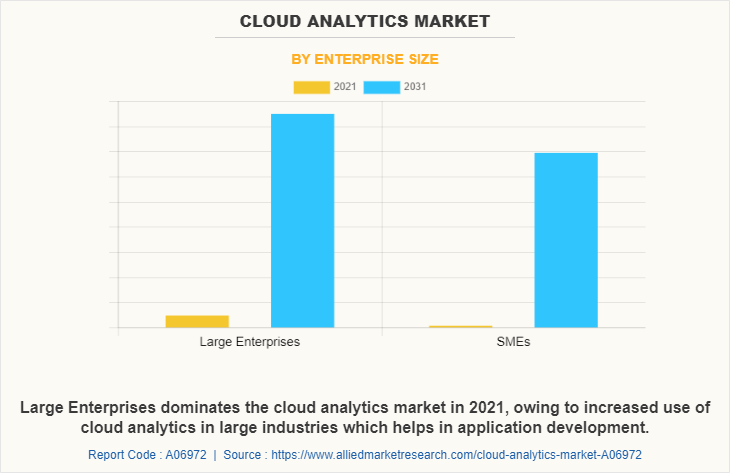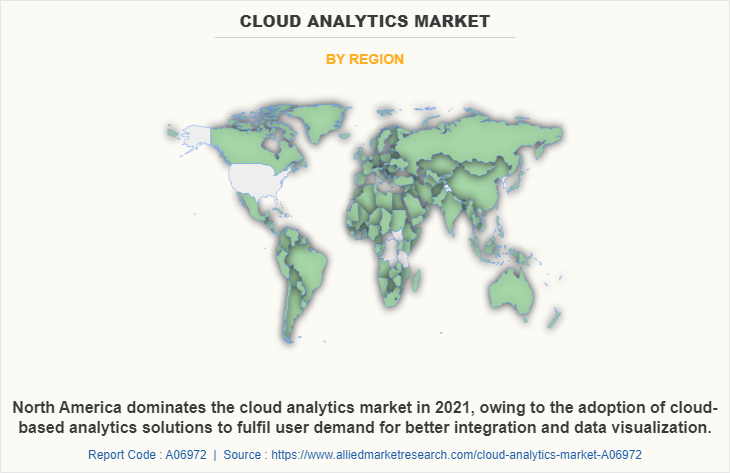Cloud Analytics Market Insights, 2031
The global cloud analytics market size was valued at USD 25.4 billion in 2021, and is projected to reach USD 174.5 billion by 2031, growing at a CAGR of 21.5% from 2022 to 2031.
Easy access and connectivity by business intelligence, increased demand of analytics solutions, and integration of network infrastructures with Software-Defined Networking (SDN) are the key factors that drive of the growth of the global market trends. However, privacy and data security issues with confidential data and lack of internal IT experience and resources are expected to hinder the growth of the cloud analytics market. Moreover, increasing data connectivity through hybrid cloud environment is expected to offer remunerative opportunities for expansion during the cloud analytics market forecast.

Cloud analytics is the method of storing and analyzing data in cloud and using the analytics to extract the business visions. Cloud analytics defines the application of analytic algorithm in cloud performed on data in a public or private cloud to deliver the result which the user wants. Cloud analytics (CA) includes deployment of the scalable cloud computing with powerful analytic software to recognize the patterns in the data and extract the required data.
Cloud analytics typically accelerates the business reliance on the data analysis, and thus, providing an advantage to discover an advance analytics method and improve the data analytics technology. It is valuable tool that adds quality and value to the data. It uses a variety of analytical tools and approaches to help businesses by enabling information from huge amounts of data to be easily categorized and accessed through a web browser.
Normally, business generate terabytes of data in their daily operations. This huge data generation are usually sourced from the websites, social media, financial software, IT devices, and other operations on data in cloud. The cloud analytics software is mainly well-organized for processing the large and massive data sets, producing vision which is easily understandable and so the results come out in better form.
The cloud analytics market is segmented on the basis of solution, deployment mode, enterprise size, industry vertical, and region. Based on solution, it is segmented into cloud BI tool, enterprise information management, hosted data warehouse solution, enterprise performance management, government, risk, and compliance, analytics solution, and others.
As per deployment mode, it is divided into public cloud, private cloud, and hybrid cloud. As per enterprise size, the cloud analytics market is categorized into large enterprise and SME’s. Depending on industry vertical, the market is categorized into BFSI, IT and telecom, government and public sector, retail and e commerce, manufacturing, healthcare, and others. Region wise, it is analyzed across North America, Europe, Asia-Pacific, and LAMEA.
The key players profiled in the cloud analytics market analysis are Amazon Web Service, IBM, Google, Hewlett Packard Enterprise, Oracle Corporation, TIBCO Software Inc., Teradata Corporation, SAP SE, and Microsoft Corporation. These players have adopted various strategies to increase their market penetration and strengthen their position in cloud analytics industry.

Depending on the enterprise size, the large enterprise segment dominated the cloud analytics market share in 2021 and is expected to continue this trend during the forecast period, owing to requirement for increased resilience, improved security, and lower costs. Moreover, the large enterprise uses cloud analytics which helps in speeding application development and deployment, also PaaS platforms can provide environment to further simplify development.
However, the SMEs segment is expected to witness the highest growth in the upcoming years, owing to the cloud analytics services which boost the productivity, save time and money for business, which create the opportunities for cloud analytics in the market.

Region-wise, the cloud analytics market size was dominated by North America in 2021 and is expected to retain its position during the forecast period, owing to the adoption of cloud-based analytics solutions to fulfil user demand for better integration and data visualization. In addition, the rising shift towards subscription-based services, increased penetration of smartphones, and technological advancement in the region have bolstered the regional market. However, Asia Pacific is expected to witness significant growth during the forecast period, owing to the growing adoption of data analytics and cloud computing in the region.
Top Impacting Factors
Increased Demand of Analytics Solutions
The rising digitalization trends, the availability of a wide range of data, and the desire to remain at the forefront of competition have led organizations to focus on analytics solutions, which supports them to adopt the strategic decision-making process. These days, businesses are moving towards digitization to improve business strategies through analyzing a large amount of unstructured data flowing through various platforms.
In addition, according to the International Data Corporation (IDC), 80% of the global data collected among enterprises will be unstructured by 2,025. This growth of unstructured data has prompted businesses to implement various business management tools based on the cloud to understand global trends, customer demand, and competitor benchmarks. These analytics solutions are helping companies to make better decisions based on historical and present data. This will help the company function more smoothly and effectively.
Integration of Network Infrastructures with Software-Defined Networking (SDN)
SDN aims to increase a network's adaptability and manageability. By separating the control plane from the data forwarding task in individual networking devices, it centralizes management. Additionally, the integration of SDN with current network architecture offers a variety of advantages, including lowering the complexity of statically defined networks, making network services much more accessible through automation trends, and making it easier to provision and manage networked resources.
Furthermore, several end-user organizations are often integrating their network infrastructure with SDN. For instance, in September 2,020, Defense Information Systems Agency (DISA) is planning to deploy software-defined wide-area networking (SD-WAN) capabilities across the Department of Defense (DoD) enterprise. Such initiatives are expected to drive the cloud analytics market growth worldwide.
Technological Trends
The past few years will go down in history as the time when the normal turned entirely upside down in a matter of weeks. As the pandemic swept around the globe, governments and businesses were caught unprepared, and many of them took a massive hit on their bottom line and credibility. Inertia differed across companies and industries, and some were slow to come to grips with the new business reality.
The pandemic highlighted the need for businesses to stay swift in today’s competitive landscape. Digital investments were again an essential element of business strategy to remain resilient and recover. Cloud analytics industry and Digital investments have become more of a necessity than ever with organizations moving towards the work-from-home model and understanding the trends in big data and cloud analytics. Hybrid cloud computing affords enterprises the best of both public cloud and private cloud worlds, to host data analytics applications in a secure environment and at the same time to leverage the immense cost benefits and low time to cloud analytics market afforded by the public cloud.
Regional Insights
The cloud analytics market is growing rapidly across different regions due to the increasing demand for data-driven decision-making, scalability of cloud solutions, and the need for cost-effective analytics platforms.
North America holds the largest share in the cloud analytics market, primarily driven by the U.S. and Canada. The region’s growth is fueled by the early adoption of advanced analytics technologies and cloud computing. Major industries like finance, healthcare, and retail are utilizing cloud-based analytics to enhance decision-making, improve customer insights, and streamline operations. Additionally, the presence of major cloud service providers such as Amazon Web Services (AWS), Microsoft Azure, and Google Cloud significantly boosts the region's market growth. North American companies are also increasingly shifting from on-premise solutions to cloud-based analytics for better scalability and flexibility.
Europe is a key market for cloud analytics, with leading contributions from countries like Germany, the U.K., and France. The increasing focus on data privacy regulations, such as the General Data Protection Regulation (GDPR), has driven businesses to adopt secure cloud-based analytics solutions. European industries are leveraging cloud analytics to comply with regulatory standards, while also gaining valuable insights from big data. Additionally, sectors such as manufacturing, automotive, and telecommunications are increasingly adopting cloud analytics to optimize operations and enhance supply chain management. The rise of artificial intelligence (AI) and machine learning (ML) integration with cloud analytics is further boosting the market in this region.
Asia-Pacific is the fastest-growing region in the cloud analytics market, with major contributions from China, India, Japan, and Australia. The region's rapid digital transformation, increasing adoption of cloud technologies, and growing focus on data analytics are driving market growth. China and India, in particular, are witnessing a surge in cloud analytics adoption across industries like e-commerce, telecommunications, and finance. Governments in the region are also pushing digitalization efforts, leading to higher adoption of cloud platforms. Moreover, the rise of small and medium-sized enterprises (SMEs) in the region and their reliance on cloud-based services for cost-efficiency and scalability is accelerating the market's expansion.
Latin America and the Middle East and Africa are emerging regions in the cloud analytics market. In Latin America, Brazil and Mexico are seeing an increase in cloud adoption due to the growing need for advanced data analytics across industries like banking and retail. Meanwhile, the Middle East and Africa, particularly in the UAE and South Africa, are experiencing a rising demand for cloud-based analytics to support digital transformation initiatives and enhance decision-making in government and private sectors. The expansion of cloud infrastructure and growing internet penetration are further fueling the growth of cloud analytics in these regions.
Key Industry Developments
February 2023: Google Cloud announced the expansion of its BigQuery platform with advanced AI and machine learning capabilities in Europe, helping organizations integrate predictive analytics into their cloud infrastructure. This development aims to boost the adoption of cloud analytics across European industries, particularly in finance and retail.
April 2023: Microsoft Azure introduced its cloud analytics service in India, enabling enterprises to leverage real-time data insights for enhanced decision-making. The service is part of Microsoft’s initiative to support India’s digital transformation efforts and meet the growing demand for cloud-based analytics solutions in industries such as healthcare, retail, and manufacturing.
June 2023: Salesforce launched its Tableau Cloud Analytics solution in Japan, targeting the region’s growing need for advanced analytics in sectors like telecommunications, banking, and manufacturing. The new solution aims to help businesses derive actionable insights from big data using AI-powered cloud analytics.
August 2023: Alibaba Cloud expanded its cloud analytics services across Southeast Asia, providing local businesses with advanced data analytics solutions to enhance decision-making and operational efficiency. This move is part of Alibaba’s strategy to strengthen its cloud business in the Asia-Pacific region, with a focus on e-commerce and logistics industries.
Key Benefits for Stakeholders
- The study provides an in-depth analysis of the global cloud analytics market growth along with current & future trends to explain the imminent investment pockets.
- Information about key drivers, restraints, & opportunities and their impact analysis on global cloud analytics market trends is provided in the report.
- The Porter’s five forces analysis illustrates the potency of the buyers and suppliers operating in the industry.
- The cloud analytics market analysis from 2022 to 2031 is provided to determine the market potential.
Cloud Analytics Market Report Highlights
| Aspects | Details |
| Market Size By 2031 | USD 174.5 billion |
| Growth Rate | CAGR of 21.5% |
| Forecast period | 2021 - 2031 |
| Report Pages | 310 |
| By Enterprise Size |
|
| By Industry Vertical |
|
| By Solution |
|
| By Deployment Mode |
|
| By Region |
|
| Key Market Players | Hewlett Packard Enterprise GlobalSoft Private Limited, SAP SE, SAS Institute Inc., Teradata Corporation, IBM CORPORATION, Microsoft Corporation, TIBCO Software Inc., Google LLC, Amazon Web Services, Oracle Corporation |
Analyst Review
According to the insights of the CXOs of leading companies, the global cloud analytics market indicates a promising picture for the cloud service industry. The recent business state has witnessed an increase in the adoption of cloud services and analytics technology, particularly in the developing regions. The companies have been implementing innovative techniques to provide advanced and innovated product and service offerings to the customers. Moreover, the evolution of Industry 4.0 and its adoption across all sectors is encouraging organizations to move to the cloud.
Data science and analytics has been a trending subject since the past decade. Storing this data economically and securely is one of the top priorities of an organization which is where the cloud comes into the picture. Moreover, the assessment of large data sets cannot be measured and evaluated by people on their own. However, the development and application of operative machine learning systems and algorithms, enable businesses to realize data science and analytics practically. This can be possible to achieve through huge deployment of cloud services across the globe.
Furthermore, the Analytics as a Service (AaaS) market is a consolidated market, as vendors such as Atos, Cloudera Inc., Google LLC (Alphabet Inc.), and Hewlett Packard Enterprise Company account for a major share globally. However, the market is expected to become fragmented in near future, as many players in the developing countries are evolving in this area and are coming up with enhanced and innovative cloud services and strategies.
The global cloud analytics market size was valued at $25.4 billion in 2021, and is projected to reach $174.5 billion by 2031
The cloud analytics market is projected to grow at a compound annual growth rate of 21.5% from 2022 to 2031.
Top companies to hold the market share in cloud analytics market are Amazon Web Service, IBM, Google, Hewlett Packard Enterprise, Oracle Corporation, TIBCO Software Inc., Teradata Corporation, SAP SE, and Microsoft Corporation.
The largest regional for cloud analytics market will be North America.
The rising digitalization trends, the availability of a wide range of data, and the desire to remain at the forefront of competition have led organizations to focus on analytics solutions, which supports them to adopt the strategic decision-making process. Additionally, the integration of SDN with current network architecture offers a variety of advantages, including lowering the complexity of statically defined networks, making network services much more accessible through automation trends, and making it easier to provision and manage networked resources.
Loading Table Of Content...



